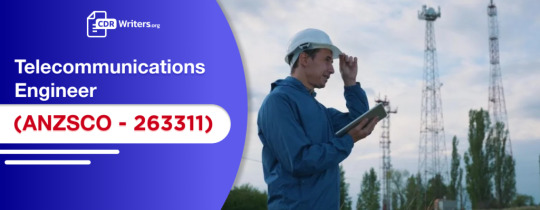#TelecommunicationEngineeringCDR
Explore tagged Tumblr posts
Text
CDR Report Writing for Telecommunications Engineers ANZSCO 263311
Designs develop and produce telecommunications systems, devices, and products.

Skill Level for Telecommunications Engineers
Level 1 or Equivalent
For most occupations within this category, a bachelor's degree or higher education is usually required. However, in some cases, a minimum of five years of relevant experience or a vendor certification can be substituted for formal education. Some positions may also require a combination of formal education, relevant professional experience, and on-the-job training. (ANZSCO Skill Level 1)
Skill Assessment Authority
EA (Engineers Australia) / AIM
Specializations of Telecommunication Engineer:
Signals Officer (Army) (NZ)
Computer Systems Integrator
Visa provision:
Telecommunications Engineering Professionals can apply for various visas through the General Skilled Migration (GSM) Program as this profession is in high demand in Australia and listed on the MLTSSL. The available visa categories include Skilled Nominated Subclass 190, Skilled Independent Subclass 189, and Skilled Work Regional Subclass 491. Moreover, employer-sponsored visas are also available if the applicant has a confirmed job offer.
Occupations in this Group
263311 Telecommunications Engineer.
263312 Telecommunications Network Engineer.
To be eligible for Telecommunications Engineers, applicants must demonstrate language proficiency by achieving minimum scores on standardized tests. The required scores are as follows:
IELTS: Minimum score of 6 in Listening, Reading, and Writing, and a score of 7 in Speaking, with an overall score of 7.
PTE Academic: Minimum score of 50 in Listening, Reading, and Writing, and a score of 65 in Speaking, with an overall score of 65.
TOEFL iBT: Minimum score of 12 in Listening, 13 in Reading, 21 in Writing, and 23 in Speaking, with an overall score of 93.
Telecommunications Engineers are responsible for:
Identifying new telecom locations and preparing approval paperwork.
Creating and approving building plans for telecom infrastructure.
Ensuring uniformity in telecom network supply through adherence to rules, laws, policies, and procedures.
Integrating communication networks by building, configuring, and developing satellite and digital data systems.
Ensuring telecom systems interact with hardware from various manufacturers, service providers, and customers.
Creating project proposals to establish priorities, define scope and needs and calculate costs.
Making buying decisions for new products and services from vendors.
Producing and evaluating drawings for telecom systems.
Creating standard diagrams and instructions for using telecom equipment.
Selecting the best hardware and software standards for effective communication.
Identifying and assessing contemporary telecom network needs and difficulties.
Investigating and examining issues related to interruption, comprehensibility, and clarification to prevent and lessen existing and future problems.
If any queries regarding the cdr report call us at +61 480 096 967 or email us at [email protected]
#TelecommunicationEngineeringCDR#CDRReportForEngineers#CDRWritingTips#CDRReportTemplate#CivilEngineeringDrafting#CDRReportSample#ANZSCOCivilEngineeringDraftsperson#AustralianCDRWritingServices#BestCDRWritingServiceSydney#ElectricalEngineeringCDRReport#TelecommunicationEngineeringCDRReport#CDREpisodeWritingExperts#RPLReportWritingTips
0 notes
Text
CDR Report Writing for Mining Engineer ANZSCO 233611

Mining engineers are in charge of coordinating and planning the engineering required to extract minerals from the earth. This involves conducting preliminary surveys with the help of mineral experts, such as prospectors, geologists, and geophysicists, to identify available resources. Mining engineers are responsible for planning and managing the engineering aspects of mineral extraction. It may be necessary for these professionals to obtain licenses or register to work in this field.
The skill level for Mining Engineers is Level 1 or Equivalent. Generally, a bachelor's degree or higher is required to demonstrate proficiency for most positions in the Production or Mining Engineer category. However, some individuals without a formal degree may still be considered qualified if they have a minimum of five years of relevant experience and/or vendor certification. These positions, classified as ANZSCO Skill Level 1, may have prerequisites that include both formal qualifications and additional on-the-job training or experience.
Skill Assessment Authority
EA (Engineers Australia) / AIM
Specializations of Mining Engineer:
Process Engineer (Mining)
Occupations in this Group.
233611 Mining Engineer (excluding Petroleum)
233612 Petroleum Engineer.
Visa Provision:
Mining engineers are highly sought after in Australia, and they are listed on the MLTSSL. This means that candidates may be able to apply for a visa under the General Skilled Migration (GSM) Program, which includes visa subclasses such as Skilled Independent Subclass 189, Skilled Work Regional Subclass 491, or Skilled Nominated Subclass 190. Moreover, if a candidate has a job offer, they may also be eligible to apply for an employer-sponsored visa.
Mining engineers are required to demonstrate language proficiency
They can meet this requirement by obtaining certain scores on standardized tests such as IELTS, OET, PTE Academic, or TOEFL iBT
For IELTS, they need a score of at least 6 in listening, reading, and writing, and a score of 7 in speaking, with an overall score of 7
For OET, they need at least a B in each section
For PTE Academic, they need a minimum score of 50 in listening, reading, and writing, and a score of 65 in speaking, with an overall score of 65
For TOEFL iBT, they need at least 12 in listening, 13 in reading, 21 in writing, 23 in speaking, and an overall score of 93.
The tasks of Mining Engineers typically include:
Conducting preliminary surveys with the help of mineral experts, geologists, geophysicists, and prospectors to identify mineral resources.
Designing and planning the engineering aspects of mineral extraction, including developing strategies for drilling, blasting, and excavating.
Developing and implementing plans for the mine infrastructure, such as roads, rail links, and storage facilities.
Managing the construction and maintenance of mining equipment, as well as monitoring and optimizing its performance.
Ensuring compliance with environmental regulations and overseeing remediation efforts.
Analyzing data on mining production, costs, and efficiency to optimize operational processes.
Managing teams of miners, technicians, and other professionals involved in the mining process.
Maintaining communication with stakeholders, including mine owners, investors, government agencies, and local communities.
#TelecommunicationEngineerCompetencyDemonstrationReport#CDREpisodeWritingServiceAustralia#RPLReportWritingExperts#ProfessionalCDRWriters#CDRWritingAssistance#CDRFilePreparation#CDRReportFormat#CivilEngineeringAssessment#CDRReportGuidance#AustralianCDRWritingGuidance#CivilEngineeringSkillsAssessment#TelecommunicationEngineeringCDR#cdr help#cdr australia#cdr writing services#cdr engineers
0 notes